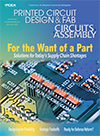Dyne-A-Mite IT CO2 Plasma is said to provide superior surface treatment to improve adhesion on a wide variety of materials. The use of gas or liquid-phase CO2 with atmospheric plasma discharge surface pretreatment technology can remove micron and submicron particulates and hydrocarbon-based contaminations on plastics and metals. Increases surface tension of base substrates. Bonding strength is said to be improved. Is suitable for either initial or final cleaning, and for cleaning applications.
Enercon, www.enerconind.com/treating
The OUC-500 Wave Unload Flat Belt conveyor station provides a means to unload PCBs from the wave. The ESD flat belt is said to be 500 mm and can handle PCBs up to 17" in width. Comes standard with variable speed control and three topside fan arrays. Framing system can be adjusted.
Promation, www.pro-mation-inc.com
The NSM series wave soldering machine has a modular design and dimensions of 4376 x 1620 x 1710 mm. Features include conveyor speed of up to 2000 mm/min; flux flow of 20 to approx. 100 ml/min.; transparent windows; closed loop with inverter control system; flux level checked by non-osculation inductor; hermetical container; three pre-heaters in forced air convection 1.8 m preheating zone; electromagnetic and motorized pumping for solder bath, and optional nitrogen configuration.
JT Electronic Equipment Co., www.jt-ele.com
Kimtech Pure W3 dispenser for presaturated alcohol wipes is said to provide one-handed dispensing with no need to hold a package or reseal a closing flap. Features include self-closing, self-sealing lid; extractor arm that is said to automatically lift each wiper, and a design that reportedly doesn’t generate particles. Available in three formulations, including 70% isopropyl alcohol/30% deionized water. Wipers are continuous filament double-knit polyester.
Kimberly-Clark Professional, www.kcprofessional.com
Performance Upgrade packages for CBT6000 and Model 8000 automatic wire bonders and the Model 3500 component placement work cell include improved vision systems for pattern recognition and Bond Data Miner. BDM is a software package that monitors machine and process trends; can track and archive traceability data for each part, die, wire and bond; said to automatically adapt process parameters to address lot to lot and/or part variations; reports its own uptime and statistics to any computer.
Palomar Technologies, www.palomartechnologies.com
Palomar Technologies, www.palomartechnologies.com
Hysol FP4581 and Hysol FP4583 are liquid epoxy encapsulants for use as underfills for flip-chip devices. FP4581 is a high-purity, liquid epoxy encapsulant formulated specifically for the requirements of high-lead, bumped large die flip-chip packages. Low CTE properties, improved toughness; forms rigid, low stress seal that dissipates stress on solder joints and extends thermal cycling performance. Ideal for flip-chip devices that require improved crack and fracture resistance. Compatible with most no-clean flux systems. Contains fillers less than or equal to 2 µm in diameter and has been formulated for use with overmolded components in high-lead and Pb-free applications. Amine-based underfill systems are said to offer excellent adhesion to SiN and polyimide. Both are designed to deliver lower stress with the combination of thermal mechanical characteristics to prevent delamination, bump fatigue and UBM failure.
Henkel Corp., www.henkel.com/electronics
Henkel Corp., www.henkel.com/electronics
Press Releases
- Altus Group Expands Aftersales Team to Its Largest Size to Date
- Incap Estonia Invests in New Flying robe System to Advance Production Performance
- Critical Manufacturing Partners with Canonical to Expand Cloud-Native Deployment Options for Manufacturers
- Heller Industries Becomes the Latest Partner to Join THE SMT FUTURE EXPERIENCE


